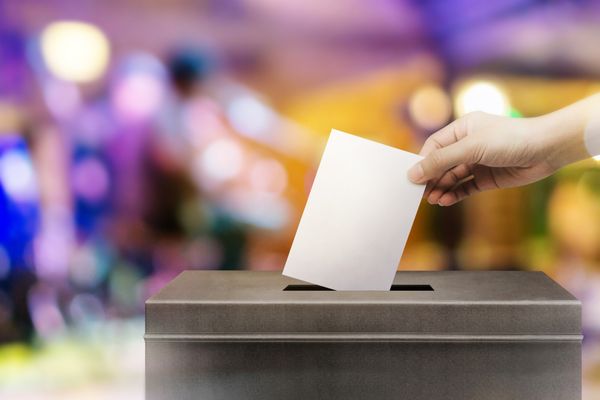4.1.1
Johnson
Johnson's Policy in Vietnam
Johnson's Policy in Vietnam
In November 1963 Kennedy was assassinated and Lyndon B Johnson took over as President. Johnson had little choice but to carry on Kennedy’s policy and involvement in Vietnam.


The situation in 1963
The situation in 1963
- By 1963, Kennedy's administration was divided. Some wanted to put in greater military support in Vietnam and others wanted to err on the side of restraint.
- Johnson wanted a South Vietnam victory without the war becoming ‘Americanised’.
- He continued US commitment to Kennedy’s counterinsurgency strategy and increased the number of US political advisers in Vietnam from 16,300 to 23,000.


The Vietnam issue in Europe
The Vietnam issue in Europe
- There was little support for the Vietnam issue in Europe.
- Members of SEATO (Australia, New Zealand, Thailand and the Philippines) used their commitment to anti-communism as a justification for involvement.


The Gulf of Tonkin resolution 1964
The Gulf of Tonkin resolution 1964
- On 2nd August 1964, a US naval vessel, the USS Maddox was attacked twice by North Vietnamese torpedo boats in the Gulf of Tonkin which is off the coast of North Vietnam.
- In response to this on 7th August, The American Congress passed the Gulf of Tonkin Resolution.
- This authorised President Johnson to take any measures he believed were necessary to retaliate in order to maintain international peace and security in southeast Asia.


Demoralised Southern Vietnamese army
Demoralised Southern Vietnamese army
- This increased the strength of the Vietcong which was made more significant because the Southern Vietnamese army was demoralised by poor leadership, lack of equipment and resources.


The situation in 1964
The situation in 1964
- By 1964 the war in Vietnam was escalating and North Vietnam seemed to be winning. The reasons for this were:
- China had agreed to support North Vietnam and the USSR sent military equipment to them.
- The People’s Army of Vietnam used the Ho Chi Minh Trail (a network of trails that ran from the North of Vietnam to Laos and Cambodia).
- This trail was used to move weapons and resources necessary for the communist supporters, the Vietcong, in the South of Vietnam.


The position of the USA
The position of the USA
- The US military advisers also had achieved very little in the south.
- After his victory in the 1964 election, President Johnson made the decision to escalate the American participation in the Vietnamese War.


Historical interpretation
Historical interpretation
- Historian John Lewis Gaddis in On Grand Strategy looks at Kennedy's policy on Vietnam: “Without the United States,” John F. Kennedy warned a Texas audience on the morning of November 22, 1963, “South Vietnam would collapse overnight,” and American alliances everywhere were equally vulnerable. For, as Kennedy added: “We are still the keystone in the arch of freedom.”
Tactics of the Americans & Operation Rolling Thunder
Tactics of the Americans & Operation Rolling Thunder
In total, the USA dropped 3 million tonnes of bombs in Vietnam. This was more than all the bombs dropped in Europe during World War Two.


Tactics of the American forces
Tactics of the American forces
- American troops were sent on patrols to try and find the Vietcong.
- They would be able to call in support by air and artillery if attacked by the Vietcong.
- These missions were known as search and destroy. The American soldiers would search the jungle and villages of Vietnam to ‘take the war to the enemy’.
- This strategy proved difficult as the Vietcong were well adapted to fighting in the jungle and had vast underground tunnels that they could hide in.


My Lai Massacre 1968
My Lai Massacre 1968
- In 1968 US soldiers, searching for Vietcong guerrillas, raided the village of My Lai.
- They killed around 300 civilians, including women and children.


Chemical weapons and bombing
Chemical weapons and bombing
- The USA also turned to aircraft to deploy napalm, a chemical that burnt skin to the bone, on suspected Vietcong areas.
- They also used Agent Orange, a powerful defoliant, to destroy jungle cover. This often also hit villagers and contaminated food supplies.
- Throughout the war, the USA continued to use high altitude bombers to drop heavy bombs in North Vietnam.
- Television propaganda in the USA reported the ‘body count’ of estimated communist casualties in a bid to gain support for the war.


Operation Rolling Thunder
Operation Rolling Thunder
- In February 1965, Johnson announced that he was starting a campaign called ‘Operation Rolling Thunder’.
- This was the bombing of strategic military targets in North Vietnam.
- Targets included the capital city, Hanoi, bases and supply routes such as the Ho Chi Minh Trail for the Vietcong.
- The goals were:
- Boost the morale of the Southern Vietnamese army.
- Destroy the infrastructure of the North Vietnamese so they couldn’t transport weapons and goods.
- Force the North Vietnamese to stop assisting guerrilla fighters in the South.


The 4 Point Demand
The 4 Point Demand
- North Vietnam responded by issuing a 4 Point Demand which stated that:
- 1) The North wanted the USA to withdraw its troops from the South of Vietnam.
- 2) that North and South Vietnam should not enter into a military alliance which involved any foreign power that suggested Vietnam was split into North and South.
- 3) External influence needed to be withdrawn from South Vietnam when dealing with internal affairs.
- 4) There should be a peaceful reunification between the North and South.


The escalation of US involvement
The escalation of US involvement
- Despite this proposal being in line with the Geneva agreements, Johnson refused to accept the 4 Point Demand. He feared that a united Vietnam would fall to communism.
- Johnson publicly declared in July 1965 that he would escalate the US involvement in Vietnam.
- In 1965, Johnson sent two battalions of US Marines to protect military bases at Da Nang. This was a shift away from Kennedy’s policy of using ‘military advisors’ in Vietnam to instead using combat troops.
- In 1965 there were 184,000 American troops in Vietnam and by 1968 there were 536,000.
Tactics of the North Vietnamese
Tactics of the North Vietnamese
The Vietcong and the North Vietnamese Army used Guerilla tactics.


Guerilla warfare
Guerilla warfare
- The Vietcong and the North Vietnamese Army did not use conventional warfare.
- Instead, they used guerrilla tactics. This involved using the cover of the jungle to their advantage by using a system of complex tunnel systems.
- The Vietcong fought a hit-and-run guerrilla war against inexperienced American soldiers, many of whom were young conscripts.


The impact of guerilla warfare
The impact of guerilla warfare
- The guerrilla tactics that were used in the jungle were booby traps.
- In the booby traps, various implements such as sharpened sticks of bamboo were hidden.
- The threat of an invisible enemy and hidden traps had a demoralising psychological impact on US troops.


International support for the North Vietnamese
International support for the North Vietnamese
- China also sent 300,000 troops to assist the North Vietnamese.
- Both China and USSR supplied the Vietcong with weapons and equipment. Weapons included assault rifles, combat weapons, surface-to-air rifles and mines.
- The Vietcong also used supply routes such as the Ho Chi Minh Trail.


The Tet Offensive 1968
The Tet Offensive 1968
- At the end of January 1968 was the Buddhist New Year (Tet) celebrations.
- The Vietcong used the cover of this to change tactics and launched hundreds of attacks on US-held areas across South Vietnam, including the US Embassy in Saigon.
- This was very uncharacteristic of the tactics used by the Vietcong; rarely did they want to wage an attack on the US as they knew that they had far superior firepower.


Failure of the Tet Offensive
Failure of the Tet Offensive
- The Vietcong had hoped that the attacks would lead to a nationalist uprising.
- Despite catching the Americans by surprise, the Vietcong lost 25,000 soldiers.


Psychological impact of the Tet Offensive
Psychological impact of the Tet Offensive
- The Tet Offensive was shown on American TV. It showed the American people that despite all the soldiers, bombs, and money spent in Vietnam, they were not making progress against communism.
- This proved to the American people that the North Vietnamese would be unlikely to surrender in the near future.
- The decision was made to de-escalate the war in Vietnam.
- In March 1968 Johnson announced that he would not stand for re-election.
- He was succeeded in January 1969 by Richard Nixon as President of the USA.
1Origins of the Cold War, 1945-9
1.1Events of 1945
1.2The Collapse of the Grand Alliance
1.3Developing Tensions
1.4US Involvement in Europe
2Widening of the Cold War
2.1US Containment in Asia
2.2The Korean War
2.3Increasing Cold War Tensions, 1949 -1953
3The Global War
3.2Cold War Rivalries
3.3Conflict in Asia
3.4Confrontation Between Superpowers
4Confrontation & Cooperation
4.2Cooperation
4.3Pressures on the USSR
5Brezhnev Era
5.1Detente
5.2Second Cold War
5.3Developments in Africa & Americas
6Ending of the Cold War
6.1Gorbachev
6.2Cooperation between US & USSR
6.3Collapse of Communism in Eastern Europe
6.4End of Tensions Across the World
Jump to other topics
1Origins of the Cold War, 1945-9
1.1Events of 1945
1.2The Collapse of the Grand Alliance
1.3Developing Tensions
1.4US Involvement in Europe
2Widening of the Cold War
2.1US Containment in Asia
2.2The Korean War
2.3Increasing Cold War Tensions, 1949 -1953
3The Global War
3.2Cold War Rivalries
3.3Conflict in Asia
3.4Confrontation Between Superpowers
4Confrontation & Cooperation
4.2Cooperation
4.3Pressures on the USSR
5Brezhnev Era
5.1Detente
5.2Second Cold War
5.3Developments in Africa & Americas
6Ending of the Cold War
6.1Gorbachev
6.2Cooperation between US & USSR
6.3Collapse of Communism in Eastern Europe
6.4End of Tensions Across the World
Unlock your full potential with Seneca Premium
Unlimited access to 10,000+ open-ended exam questions
Mini-mock exams based on your study history
Unlock 800+ premium courses & e-books